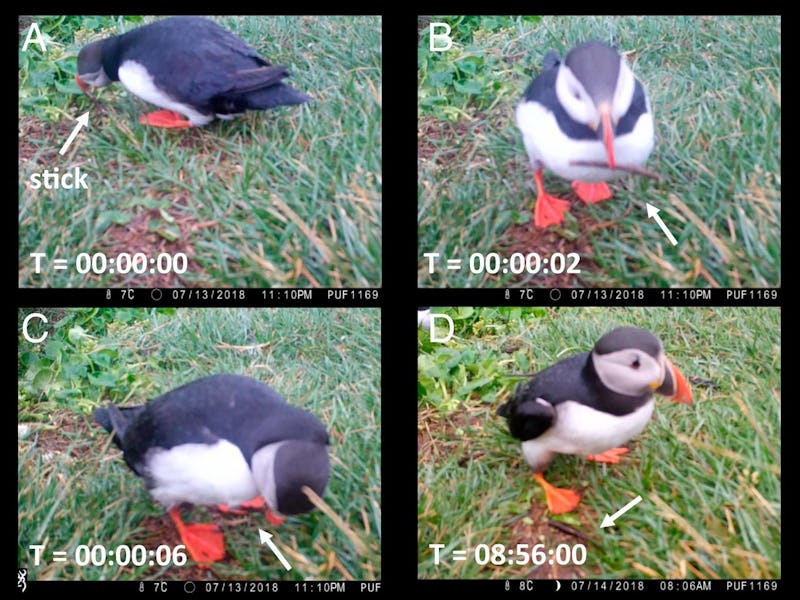You can learn a lot from a back-scratching puffin -- study
Puffins love a little scritch-scritch.

Dear puffins: Our bad. You may be a lil dopey-looking, but it turns out you’re much smarter than we humans have given you credit for.
While studying several Atlantic puffin breeding colonies, researchers in Iceland observed the birds doing something remarkable: The puffins used tools.
Specifically, they saw two puffins, from separate colonies, using wooden sticks to scratch their bodies, publishing the findings on Monday in a study in the journal Proceedings of the National Academy of Sciences.
The news is big not only for puffins, but for all seabirds — which the researchers say were “previously thought to lack the ability, need, or opportunity to use tools.” The sea-dwelling avian order can be counted amongst the birds that have figured out “body-care-related tool use.”
It’s significant, the researchers say, that puffins use tools for something besides just extracting food — a common reason animals use sticks in particular. I mean, you can’t blame the puffins for finding a better way to do a little scritch scritch. How else are these little guys supposed to get that hard-to-reach place on their small puffin bodies?
Both of the puffins observed expertly scratching were adults. One, located in Wales, used a wooden stick to scratch its back for approximately five seconds, and another, caught on camera in Iceland, used the same method to scratch its chest.
The significant distance between those two geographic points — more than 1,000 miles apart — leads researchers to believe that “occasional tool use may be widespread in this group, and that seabirds’ physical cognition may have been underestimated.”
As for why the puffins were scratching? We all get a lil’ itch now and then, but the specific need for puffins to scratch might be specific to their location. Puffins can be plagued with seabird ticks, of Ixodes uriae, which were particularly abundant in Grímsey Island, Iceland, at the time the second puffin was seen doing its scratchy thing. The stick, researchers posit, might do a better job than a puffin’s beak at dislodging the ticks.
Intelligent animals
Until now, only primates and elephants in the wild have been observed scratching with a tool, the researchers say. Parrots in captivity have been observed scratching and using other tools.
Tool use in general is more rare in and near the water, the researchers write, in part because of the lack of objects to use as tools and of concealed food sources — since foraging is a common use for tools.
Now, puffins, and seabirds more broadly, have challenged those ideas, helping them to move up in the ranks of intelligent, tool-using species. But they’re far from the only birds to be called intelligent.
Crows are famously intelligent: Not only can they use tools, but they’re able to make complex tools with four different parts. The crow first observed doing that — named Mango, adorably — was the first non-human animal to be observed completing such a feat.
In another study, published in 2018 in the journal Scientific Reports, researchers discovered that New Caledonian crows can even build tools from memory. This one, too, places crows up there with primates’ intellect.
Crow making a tool.
While crows may stand out as particularly intelligent, it may not be fair to start comparing birds. After all, puffins offer their own other strengths, too, like having evolved “unparalleled abilities to dive, swim, and catch prey underwater.”
And now, puffins can add another accolade: expert back and chest scratching. Thanks friends, for proving researchers wrong and showing us the importance across species of a little bit of self-care.
Abstract:
Documenting novel cases of tool use in wild animals can inform our understanding of the evolutionary drivers of the behavior’s emergence in the natural world. We describe a previously unknown tool-use behavior for wild birds, so far only documented in the wild in primates and elephants. We observed 2 Atlantic puffins at their breeding colonies, one in Wales and the other in Iceland (the latter captured on camera), spontaneously using a small wooden stick to scratch their bodies. The importance of these observations is 3-fold. First, while to date only a single form of body-care-related tool use has been recorded in wild birds (anting), our finding shows that the wild avian tool-use repertoire is wider than previously thought and extends to contexts other than food extraction. Second, we expand the taxonomic breadth of tool use to include another group of birds, seabirds, and a different suborder (Lari). Third, our independent observations span a distance of more than 1,700 km, suggesting that occasional tool use may be widespread in this group, and that seabirds’ physical cognition may have been underestimated.